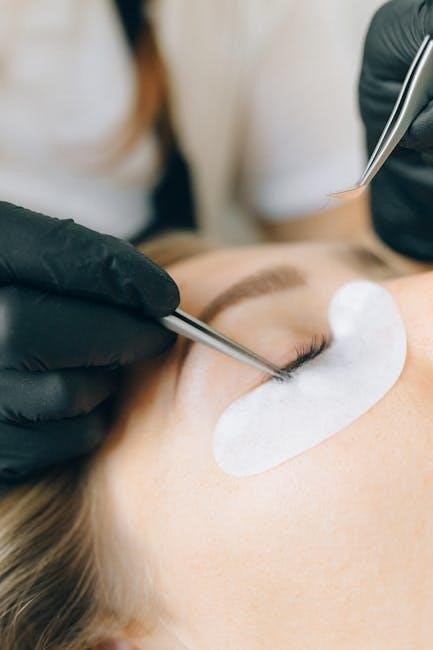Proper glove sizing ensures optimal functionality, comfort, and protection. This guide explains how to measure hand circumference and use size charts for the best fit.
Why Glove Size Matters
Proper glove sizing is crucial for both comfort and performance. Ill-fitting gloves can cause discomfort, reduce dexterity, and impair functionality. Gloves that are too tight may restrict movement, while those too loose can hinder grip and precision. Accurate sizing ensures optimal protection, whether for sports, winter, or work. A well-fitting glove enhances performance, safety, and satisfaction, making it essential to measure and choose the right size for your specific needs.
Overview of Glove Sizing Charts
Glove sizing charts provide standardized measurements to help determine the best fit. They typically include numerical sizes or letter designations (S, M, L, XL) based on hand circumference or length. Charts may vary by manufacturer, with some using inches or centimeters. They often feature sizing guidelines for men, women, and children, ensuring accuracy across different demographics. By referencing these charts, users can align their measurements with the appropriate glove size for optimal comfort and functionality.

How to Measure Your Hand for Gloves
Use a flexible tape measure to wrap around your dominant hand just below the knuckles, excluding the thumb, and make a fist for accurate sizing.
Step-by-Step Measurement Process
To ensure an accurate fit, start by using a flexible tape measure. Wrap it around your dominant hand just below the knuckles, excluding the thumb, and make a loose fist. This captures the widest part of your palm. Keep the tape snug but not overly tight. Record the measurement in inches for glove sizing. If your size falls between two options, consider the intended use and material of the gloves to decide whether to round up or down.
Choosing the Right Measuring Tool
Selecting the right tool is crucial for accurate glove sizing. Use a flexible tailor’s measuring tape, as it conforms to the natural shape of your hand. Avoid rigid rulers or standard measuring tapes, as they may not provide a snug fit. For precision, ensure the tape is wrapped tightly but not overly so. If a tape measure isn’t available, a piece of string can be used to wrap around the hand, then measured with a ruler for the same effect.
Measuring Tips for Accuracy
For precise glove sizing, measure your dominant hand, as it tends to be slightly larger. Ensure the tape measure is snug but not overly tight, wrapping it around the widest part of your palm, just below the knuckles. Keep your thumb outside the measurement to avoid distortion. If using a string, mark the point where it overlaps, then measure the length with a ruler. Consistency is key—always measure under the same conditions, such as with a bare hand, to ensure accuracy and a perfect fit.

Glove Size Charts and Conversion
Glove size charts provide standardized measurements for accurate fitting. Convert hand measurements to sizes using official charts, ensuring proper fit by accounting for manufacturer-specific variations and size ranges.
Official Glove Size Charts
Official glove size charts provide standardized measurements for consistent sizing. Measure your hand’s circumference at its widest point, excluding the thumb, using a flexible tape measure. This measurement corresponds to specific glove sizes, typically ranging from small to extra-large. Some charts use numerical sizing, while others rely on letter designations (S, M, L). Always refer to the manufacturer’s official chart, as sizing can vary slightly between brands. Proper measurement ensures the best fit and functionality for your gloves.
Converting Measurements to Glove Sizes
Converting hand measurements to glove sizes involves matching your hand’s circumference to a size chart. Measure your hand’s widest point with a flexible tape measure, then compare the measurement to the chart. If using inches, round up to the nearest half size. For example, a 7.5-inch hand typically corresponds to a size 8. Some charts use numerical sizes, while others use letter designations (S, M, L). Always refer to the manufacturer’s chart for accurate conversion, as sizing may vary slightly between brands. Proper conversion ensures a comfortable and functional fit for your gloves.
Differences in Sizing Across Manufacturers
Glove sizes can vary significantly between manufacturers due to differing sizing standards. Some brands use numerical sizes, while others rely on letter designations (S, M, L). Additionally, measurement methods may differ, with some focusing on hand circumference and others on finger length. Fit preferences, such as snug or relaxed, also influence sizing. Always check the specific size chart for the brand you’re purchasing from, as variations can lead to discrepancies. Proper fit depends on accurate measurements and understanding the brand’s sizing approach.
Factors Influencing Glove Size
Hand shape, intended use, and material preferences influence glove sizing. Proper fit depends on these factors to ensure comfort and functionality.
Hand Shape and Size Variations
Hand shape and size variations significantly impact glove fit. Slender hands may require narrower gloves, while wider hands need more room. Measure around the palm at its widest point, excluding the thumb, to determine the best fit. Longer fingers may need longer glove fingers, while shorter fingers prefer a more compact design. Accurate measurements ensure comfort and functionality, preventing gloves from being too tight or loose.
Intended Use of Gloves
The intended use of gloves plays a crucial role in determining the ideal size and fit. For instance, sports gloves require a snug fit for grip and dexterity, while winter gloves may need extra room for insulation. Work gloves often prioritize durability and protection, potentially sizing up for padding. Measuring for specific purposes ensures functionality, comfort, and safety. Always consider the glove’s purpose when selecting sizes to meet performance and comfort needs effectively.
Material and Fit Preferences
Material and fit preferences significantly influence glove sizing. Different materials, such as leather, synthetic, or wool, offer varying levels of stretch, durability, and comfort. A snug fit is ideal for sports or precision tasks, while a looser fit may be preferred for casual or insulated gloves. Consider the thickness and breathability of the material, as these factors affect comfort and dexterity. Choosing the right material ensures the glove meets both functional and personal comfort needs effectively.

Common Mistakes in Measuring Glove Size
Common errors include not using a flexible tape measure, measuring the wrong hand, and not accounting for thumb placement or fist tension during measurement.
Mistakes to Avoid for Accurate Measurements
Common errors include using a rigid measuring tape instead of a flexible one and measuring the wrong hand. Many people forget to exclude the thumb or fail to make a loose fist, leading to inaccurate results. Others measure too loosely or tightly, affecting precision. Additionally, not considering hand dominance or using outdated measurements can cause mismatches. Always ensure proper positioning and consistency to achieve the best fit. Avoid rounding down sizes, as this often results in poorly fitting gloves.
How to Ensure the Best Fit
To ensure the best fit, use a flexible tape measure and take your measurements when your hand is relaxed. Always measure your dominant hand, as it tends to be slightly larger. Consider the thickness of materials and intended use when selecting sizes. Try gloves on if possible, and ensure they fit snugly without restricting movement. Refer to manufacturer-specific size charts, as sizing can vary. Proper fit enhances comfort, dexterity, and overall performance, making it essential for optimal functionality.

FAQs About Glove Sizing
- What is the best way to measure my hand for gloves?
- Why does glove sizing vary between manufacturers?
- Should I measure my dominant hand?
- How do I convert measurements to glove sizes?
Frequently Asked Questions
Common questions include how to measure hand circumference, why sizes vary between brands, and whether to measure the dominant hand. Others ask about converting measurements to glove sizes and handling between-size scenarios. Many wonder if thumb inclusion affects sizing or if different materials require size adjustments. Additionally, users often inquire about the best tools for accurate measurements and how to interpret size charts correctly for a perfect fit. These questions are essential for ensuring optimal glove fit and functionality.
Solving Common Sizing Dilemmas
Common dilemmas include handling between-size measurements, choosing the right material, and addressing fit discrepancies. For borderline sizes, opt for the smaller size if prioritizing snugness or functionality, or the larger if preferring comfort. Material thickness can also impact fit, with thicker gloves running slightly tighter. Always refer to the specific manufacturer’s chart, as sizing can vary. If unsure, consider trying on gloves or consulting customer reviews for sizing insights to ensure the best fit.
Proper glove fit is essential for functionality and comfort. By following this guide, you’ll confidently choose the right size for your needs.
Final Tips for Choosing the Right Glove Size
- Always measure your dominant hand for accuracy.
- Use a flexible tape measure for circumference measurements.
- Consider hand shape and finger length for the best fit.
- Refer to size charts specific to the manufacturer or glove type.
- If between sizes, choose the smaller size for a snug fit.
- Account for material stretch or thickness when selecting.
This ensures comfort, dexterity, and optimal performance.
Importance of Proper Fit
A well-fitting glove ensures comfort, dexterity, and optimal performance. Proper fit prevents issues like restricted movement, blisters, or impaired grip. It also enhances protection, whether for sports, work, or cold weather. Incorrect sizing can lead to discomfort or reduced functionality, making it essential to measure accurately and choose the right size. A perfect fit guarantees both safety and satisfaction, tailoring to your specific needs and activities.